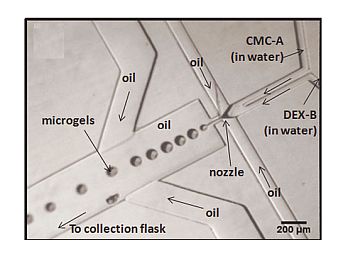 |
Injectable Hydrogels with Well-Defined Nanostructures (Sponsor: NSERC) We are developing a range of composite hydrogel-based materials that can be injected and rapidly gel in situ following the mixing of reactive precursors via injection (the hydrogel analogue of epoxy glue). By designing precursor components with well-defined sizes, compositions, self-assembly properties, and cross-reactivities, we aim to develop readily customizable, multi-phase hydrogels with high affinities for target drugs as well as optimized release kinetics.
|
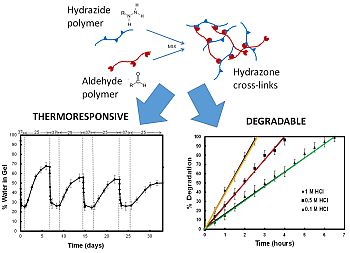 |
Degradable Analogues of Synthetic Hydrogels and Microgels (Sponsor: NSERC) We are designing a range of new microgel and hydrogel chemistries to replace the non-degradable polymer backbones of synthetic polymers (currently limiting their utility in biomedical applications) with degradable analogues, allowing us to reproduce fascinating “smart” properties of current synthetic polymers with in vivo-relevant materials. |
 |
Developing Novel Approaches for Cell Encapsulation (Sponsor: NSERC CREATE) In conjunction with the CREATE-IDEM (Integrated Design of Extracellular Matrix) network, we are developing novel chemistries and encapsulation approaches for the design of cellular therapeutics. In particular, we are focused on developing new covalent gelation chemistries to replace the current standard (but unstable) alginate-calcium gelation system and move toward single cell encapsulation to promote high cell viability |
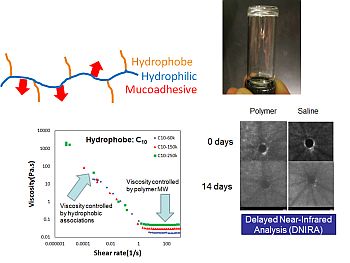 |
Drug Delivery to the Eye (Sponsor: NSERC 20/20 Ophthalmic Materials Research Network) We are developing novel hydrogel-based materials for use in the eye along four tracks: (1) Hydrogel networks that can be reversibly crosslinked and de-crosslinked with light to promote on-demand delivery of macromolecular therapeutics; (2) Self-associative polymers to promote gelation at the front of the eye and thus enhance the residence time of drugs administered via eye drops; (3) Cyclodextrin-incorporated nanomaterials and injectable hydrogels for hydrophobic drug delivery to the eye; and (4) Optically clear injectable hydrogel formulations for protein delivery to the back of the eye. |
|
|
Hydrogel-Printed Paper for Biosensors (Sponsor: Sentinel Bioactive Paper Network) We are collaborating with Dr. Carlos Filipe and Dr. Yingfu Li within the Sentinel network to develop new printable paper-based biosensors with low non-specific adsorption and highly specific binding and signal generation for DNA sensing as well as other biosensing applications. |
|
|
Remote-Control Drug Delivery Devices (Sponsor: J.P. Bickell Foundation) We are developing injectable drug delivery systems that can be triggered on and off remotely without requiring implantable electronics using combinations of thermoresponsive “smart” hydrogel materials and inorganic nanoparticles that can generate heat via non-invasive oscillating magnetic fields or near-infrared radiation. |
|
|
Microfluidic Assembly of Microgel Particles (Sponsor: NSERC) Using a novel reactive microfluidics process we have developed, we are making highly monodisperse degradable microgels with “smart” properties and exploring their use as self-assembly units for designing multi-scale hydrogels. |
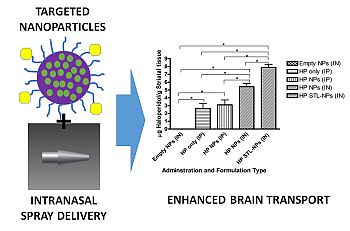 |
Targeted Nanoparticles for Crossing the Blood-Brain Barrier (Sponsor: NSERC/CIHR) In collaboration with Dr. Ram Mishra’s laboratory, we are designing both solid nanoparticle and microgel formulations to facilitate intranasal delivery of a range of novel anti-psychotic medications to the brain. |
 |
Physically-Targeted Nanoparticles for Cancer Therapy (Sponsor: Canadian Cancer Society Research Institute) Working in conjunction with Dr. Yonghong Wan in the Department of Pathology and Molecular Medicine, we are designing nanoparticles that will selectively aggregate and thus concentrate drug in the unique pH (slightly more acidic) and temperature (slightly hotter) environment of a cancer tumour relative to healthy tissue. We are also investigating how to make multi-functional nanoparticles out of these base particles that add additional potential for tumour imaging, thermotherapy, and immunotherapy to provide multi-modal treatments of malignant tumours |
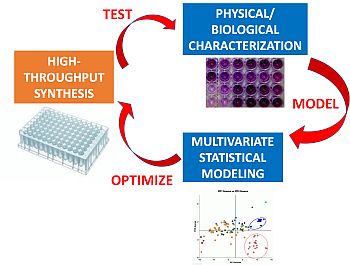 |
Accelerated Design of Biomaterials for Stem Cell Expansion (Sponsor: NSERC Strategic Grant) Working with our industrial partner ProSensus, we are combining our injectable hydrogel chemistry, high-throughput materials synthesis and screening equipment available in McMaster’s Biointerfaces Institute, and multivariate statistics/design of experiments approaches to develop a rational and accelerated process to identify new hydrogel-based biomaterial compositions that have optimized properties for specific target applications. Our first target application is developing smart, thermoresponsive surfaces for the expansion and enzyme-free recovery of mesenchymal stem cell populations, although we are also working toward tissue engineering applications. |
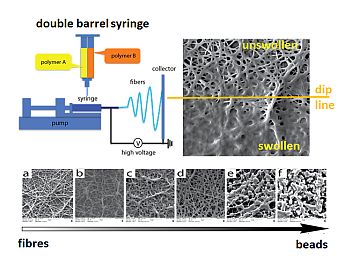 |
Development of Structured 3D Matrices for Tissue Engineering (Sponsor: NSERC) We are working on the development of well-defined structured hydrogels with both defined macropore and nanopore structures, exploiting our hydrazide-aldehyde in situ gelling hydrogel chemistry together with novel assembly of fabrication approaches. Specifically, we are engaged in projects related to direct electrospinning of hydrogel fibres as well as 3D printing of reactive hydrogels (the latter in cooperation with Dr. Ravi Selvaganapathy's group), both in conditions conducive to direct application of cells both inside or between the hydrogel structures formed. |
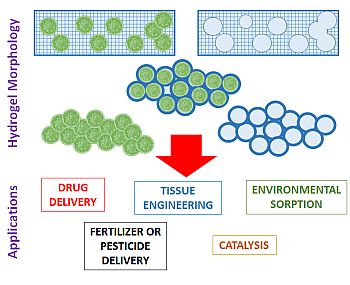 |
Design and Fabrication of Nanostructured "Smart" Hydrogels from Biopolymer Nanoparticle Building Blocks (Sponsor: NSERC Strategic Project) Working with our industrial partner EcoSynthetix, Inc., we are pursuing the fabrication of both in situ gelling and conventional-gelling hydrogels based on biopolymer nanoparticle building blocks that offer the potential to engineer hydrogel morphologies on multiple length scales not typically accessible using conventional synthesis techniques. We then apply these new compositions in a variety of biomedical (drug delivery, tissue engineering), environmental (agriculture, remediation), and industrial (catalysis) applications suited to each type of hydrogel developed.
|
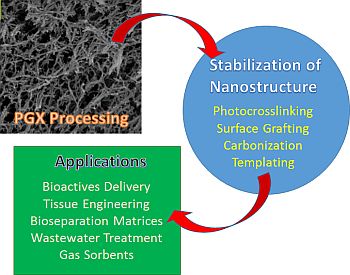 |
Development and Application of Highly Tunable Porous Biopolymer and Smart Polymer Scaffolds Using Pressurized Gas Expanded Liquids (Sponsor: NSERC Strategic Project) Working with our industrial partner Ceapro, Inc. and co-PI Dr. David Latulippe, we are working with Ceapro's proprietary pressurized gas expanded liquids (PGX) technology that achieves rapid, large-scale production of highly porous polymeric products using only food-grade solvents to produce chemically stable porous networks. Specifically, we aim to apply the exquisite control over pore size and network structure achieved with PGX processing to generate improved performance macroporous materials to improve the delivery of drugs and agricultural chemicals, generate 3D cell scaffolds maintaining high cell viability, generate low-cost alternatives for purification of antibodies and viruses, improve methods of removing heavy metal ions from industrial waste water, and enhance the capture of carbon dioxide from polluted air. |


